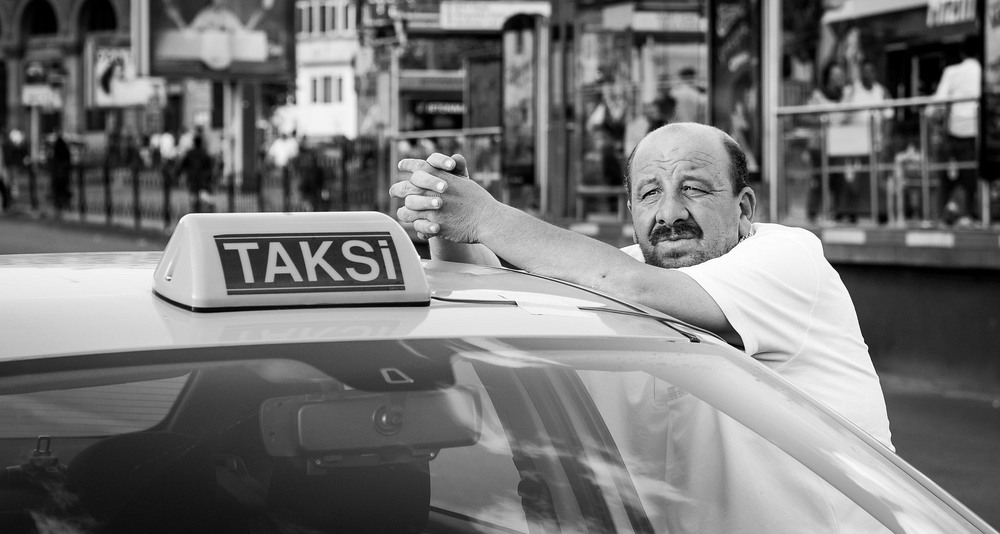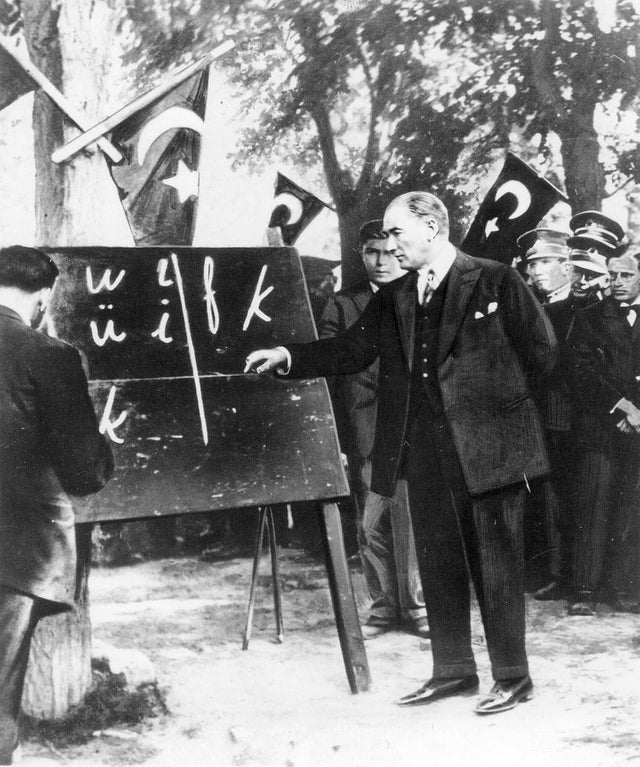
An alternative spelling for taxi in Istanbul, Turkey. Photo credit: Jürgen Luger/Flickr
In 1928, the Turkish government decided to change their alphabets. The old Turkish writing system used the Arabic script, which was so foreign in appearance that it was extremely difficult to master. Many foreigners who had lived in Turkey for years and could speak Turkish fluently still couldn’t spell or read street signs. Young children took longer to learn to read the Turkish language compared to other languages based on the Latin script. So Turkey decided to adopt the Latin script, like hundreds of other languages that already do.
“The Turkish language has been a prisoner for centuries and it is now casting off its chains,” declared President Mustafa Kemal Atatürk. Latin alphabets, he explained, was going to make the Turkish language intelligible to the western world, which will help the country move forward along with the more progressive nations.
The old Arabic alphabet had nearly five hundred characters—a nightmare for a typesetter. The new Turkish alphabet has only twenty nine characters.
A B C Ç D E F G Ğ H I İ J K L M N O Ö P R S Ş T U Ü V Y Z
It looks similar to the English alphabet because both uses the same Latin script. A few special characters (the ones with diacritics) were added to accommodate the nuances of Turkish pronunciation, while three alphabets the administration felt were redundant were dropped. In case you haven’t already noticed, these three alphabets are Q, W, and X. The argument was that these characters could be spelled using the letters K, V and KS, respectively. So “taxi” became “taksi” and “Nowruz”, the Persian New Year, became “Nevruz”.
Next came the daunting task of updating all public signs, hundreds of thousands of them across the country. Street names, shops, bus stops, business establishments, railway stations, all had to be spelled out using the new alphabets. Newspapers and periodicals threw out the old typesets, official documents were updated, text books were reprinted. Street corners were flooded with paper-covered primers teaching the new alphabets. All citizens between ages sixteen and forty were required to learn the new script and schools were opened for this purpose. In Istanbul alone nearly two hundred thousand men and women enrolled in the classes. Kemal himself embarked on a tour of Anatolia promoting the change, staging massive, quasi-theatrical tutorials and organizing Alphabet Marches.

President Mustafa Kemal Atatürk introducing the new Turkish alphabet to the people of Kayseri on 20 September 1928.

This statue shows President Mustafa Kemal Atatürk introducing the new Turkish alphabet to a child. The statue stands in Istanbul. Photo credit: dnd_project / Shutterstock.com
Changing the written language of an entire nation of fourteen million people in the space of a few weeks was an outstanding educational achievement. Although most of them went cheerfully to work at the task of learning the new ABCs, many regretted the loss of the beautiful Arabic script, whose characters form a large part of the decoration in mosques.
When Mustafa Kemal Atatürk omitted the three Latin alphabets—Q, W and X— from the Turkish alphabet, he didn’t simply drop them. He outright banned them, making their use in public an offense. The only way to legally use these letters is if they are part of a word loaned from English and other languages. For instance, one of the biggest TV channels in Turkey is “Show TV” and there are giant billboards advertising Xerox copiers. But in 2007, when the mayor of a city in southeastern Turkey sent out greeting cards wishing his citizens a Happy "Nowruz," the Kurdish and Persian New Year, charges were brought against him for using the letter W. The new spelling is “Nevruz”. Similar charges were made in the past against government officials for making the same mistake.

A “taksi” in Istanbul, Turkey. Photo credit: ArtWell/Shutterstock.com
The Kurds, who comprise roughly 20 percent of the Turkish population, bore the brunt of the alphabet law, because they rely on the three outlawed characters much more than the Turkish do. The Kurdish have their own language and their own script but until the 1990s these were banned as well. Turkish was (and still is) the only official language in the country, which forced the Kurds to use the new Turkish alphabets, but without the crucial Q, W and X, many Kurdish people had to change their names because those alphabets were not allowed in their official IDs.
The Kurds have a long history of discrimination against them by the Turkish government. Restricting their language was just another way of culturally repressing the minority group.
But all this came to a happy end on October 2013, when the Turkish government lifted the ban on Q, W and X. For the past few years, the government has been relaxing the restrictions on learning and expressing in Kurdish. In 2009, the state began running a 24-hour Kurdish television station. Previously only private television channels were allowed to broadcast Kurdish, restricted to only 45 minutes a day or four hours a week. In 2012, Kurdish-language lessons, which was only possible in private institutions, became an elective subject in public schools.
The Kurds have been scoring small victories like this, but the more pressing matters, such as electoral reform and the mass detention of Kurdish prisoners continues to remain unresolved.



Comments
Post a Comment